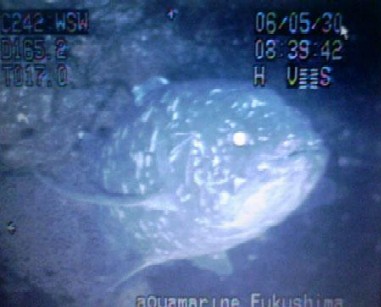New Coelacanth Video
Posted by: Loren Coleman on June 27th, 2006

A capture of an image from the Japanese research team videotape of a one-meter long coelacanth taken off Indonesia on May 30, 2006.
As first announced in May here, some startlingly clear images of living Indonesian coelacanths have been taken.
Now, a portion of the Indonesian coelacanth video shot several weeks ago has been made public. You can see a segment of the video in this short news clip on YouTube.
While the news report states that 4 Indonesian coelacanth were videotaped, Aquamarine Fukushima’s coelacanth web page claims that a total of 7 were videotaped during the period from May 30 to June 5, as follows:
– May 30 (8:00 to 9:00 AM): Successfully videotaped an Indonesian coelacanth off the northern coast of Sulawesi, at a depth of 170 meters in 17 degrees Celsius water. Length of video is 5 to 10 minutes.
– May 31 (approx. 7:30 AM): Videotaped 2 more coelacanth in the same cave where the first coelacanth was videotaped.
– May 31 (approx. 10:00 AM): Videotaped another coelacanth in a different cave located at a depth of 180 meters.
– June 4 (approx. 6:40 PM): Videotaped 3 coelacanth over the span of 2 hours at a depth of 150 meters in the same area.
Beginning July 13, 2006, Aquamarine Fukushima will hold a special exhibit dedicated to the mystery of the Indonesian coelacanth, featuring video of the fish shown on a 65-inch plasma screen. The exhibit will run for an unspecified period of time, according to the Aquamarine Fukushima coelacanth page.
The awareness and details to this data are courtesy of Cryptomundo Informant Edo.
About Loren Coleman
Loren Coleman is one of the world’s leading cryptozoologists, some say “the” leading living cryptozoologist. Certainly, he is acknowledged as the current living American researcher and writer who has most popularized cryptozoology in the late 20th and early 21st centuries.
Starting his fieldwork and investigations in 1960, after traveling and trekking extensively in pursuit of cryptozoological mysteries, Coleman began writing to share his experiences in 1969. An honorary member of Ivan T. Sanderson’s Society for the Investigation of the Unexplained in the 1970s, Coleman has been bestowed with similar honorary memberships of the North Idaho College Cryptozoology Club in 1983, and in subsequent years, that of the British Columbia Scientific Cryptozoology Club, CryptoSafari International, and other international organizations. He was also a Life Member and Benefactor of the International Society of Cryptozoology (now-defunct).
Loren Coleman’s daily blog, as a member of the Cryptomundo Team, served as an ongoing avenue of communication for the ever-growing body of cryptozoo news from 2005 through 2013. He returned as an infrequent contributor beginning Halloween week of 2015.
Coleman is the founder in 2003, and current director of the International Cryptozoology Museum in Portland, Maine.










How long ago did we think this ancient fish went extinct?
80 million years i think… until it was re-discovered earlier this century.
Magnificent.
This is great news for the crypto loving people of the world.
twblack (3) … and fish loving people generally. Who would ever have thought I could watch video footage of that classic beast in its habitat? Wonderful stuff!
After that, i am wondering why all those years people do not believe in Nessie and Champ.
The fish in the photo looks more like a grouper than a coelacanth, the fins are all wrong. Maybe the juvenile coelacanth doesn’t have the thick fleshy appendages that the adults have?
naw, groupers I thought had more traditional fin layout, this one has the odd # the coelacanths are famed for. I do believe they are one of the few living fossils, right?
I see Groupers every day at work. This is not a Grouper. This is a Coelacanth.
There is some evidence for a North/Central American Coelacanth. You know, the thought occurs to me that, given its predilection for underwater caves, Central America would be prime habitat, what with all of the cenotes. Most of the openings with ocean access are poorly explored at present.